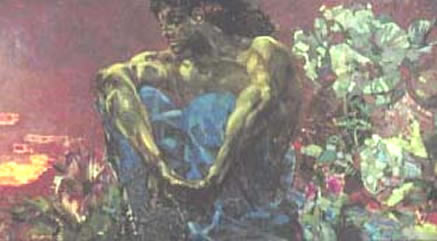|
Home>Visual
Arts>Symbolism>Introduction, Vrubel's "The Demon
Seated"
Symbolism 1 2 3
4 5
By the mid 1880s, the Russian realist movement reached
something of a watershed. Of the great writers, Dostoevsky
and Turgenev were dead, and Tolstoy had renounced art in
favor of religion. By the early 1890s, a series of new artistic
trends began to appear. Influenced initially by French literature
and art as well as by the art of Romanticism (Russian and
European), the Russian decadents and symbolists turned from
novelistic prose to lyric poetry and, eventually, to drama.
They also rejected the commonly-held belief that art should
serve social progress. Rather, they posited the artist as
a free godlike figure whose life and work could point the
way to the ideal future. In the visual arts, we can see
how abrupt the turn away from realism was if we look at
the painting of Mikhail Aleksandrovich Vrubel (1856-1910).
|
"The Demon Seated" (1890)
The subject of this painting is the hero of Mikhail
Lermontov's Romantic narrative poem of the same
name. This work, written in the late 1830s tells
the story of a Byronic demon fated to love a Georgian
princess, who dies as a result of his kiss. She
is saved by angels, while he is doomed to spend
eternity alone. This overheated story fit perfectly
with the Romantic temperament, but would have been
anathema to realist writers and painters. Vrubel
described the Demon as "A spirit which unites in
itself the male and female appearances, a spirit
which is not so much evil as suffering and wounded,
but withal a powerful and noble being." Note the
otherworldly expression in the Demon's eyes (as
opposed to the expression in Perov's portrait
of Turgenev, for example), symbolic of the existence
of a world beyond that of the everyday. Note also
the background, which is filled with such symbolically-laden
images as sunset, fire (which stands for the end
of the world), as well as aggressively nonrealistic
flowers.
 |
|